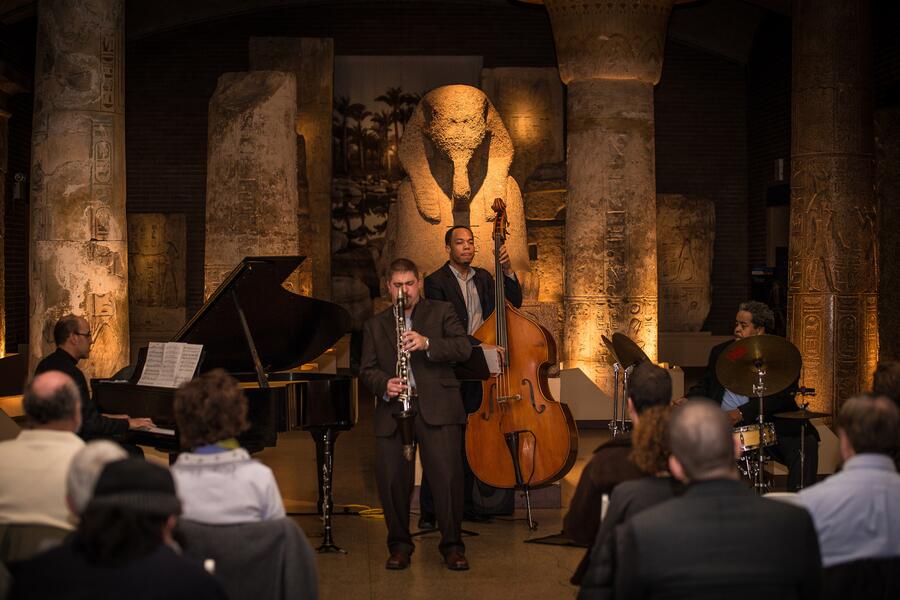The Todd Marcus Quartet is an ensemble that features my bass clarinet and clarinet along with piano, bass, and drums. This ensemble presents my original compositions and arrangements, jazz standards, and demonstrates my work of presenting the bass clarinet as a legitimate lead horn in modern jazz deserving of equal consideration with more traditional jazz horns like the saxophone and trumpet.
I've been composing and arranging my work for this group since 2005 and it allows me to give great focus to both my compositions and soloing. While some material that this ensemble performs is also featured with my large nine member jazz orchestra, there are some works that I present only in this context because of the flexibility of this small ensemble format.
The past couple years have also been important ones for me with this ensemble as I've explored the incorporation of Middle Eastern music into jazz. This has stemmed from my own journey to dig deeper into my half-Egyptian ethnicity and I think it is a insightful reflection of both my American culture (through jazz) and Egyptian culture (through Middle Eastern music). This effort has been a challenging one though as jazz and Middle Eastern music are constructed very differently. While the harmonies in jazz are a crucial element that define its sound, traditional Middle Eastern melodies typically do not use harmony and focus more on unison themes. So in many ways my efforts to merge these two musics is the perfect metaphor for me as an individual who continues to explore and integrate his Americian and Egyptian cultures.
I've been composing and arranging my work for this group since 2005 and it allows me to give great focus to both my compositions and soloing. While some material that this ensemble performs is also featured with my large nine member jazz orchestra, there are some works that I present only in this context because of the flexibility of this small ensemble format.
The past couple years have also been important ones for me with this ensemble as I've explored the incorporation of Middle Eastern music into jazz. This has stemmed from my own journey to dig deeper into my half-Egyptian ethnicity and I think it is a insightful reflection of both my American culture (through jazz) and Egyptian culture (through Middle Eastern music). This effort has been a challenging one though as jazz and Middle Eastern music are constructed very differently. While the harmonies in jazz are a crucial element that define its sound, traditional Middle Eastern melodies typically do not use harmony and focus more on unison themes. So in many ways my efforts to merge these two musics is the perfect metaphor for me as an individual who continues to explore and integrate his Americian and Egyptian cultures.
-
InheritanceInheritance is a composition of mne inspired by a Branford Marsalis composition which itself shows inspiration from a composition by John Coltrane. The title communicates this nature of how jazz musicians often build upon (and pay homage to) works of the masters that have come before us. The melody uses a repeating sparse main theme with more intricate melodies mixed in and also features the extensive low to high ranges of the bass clarinet. The first solo shows my efforts to use the bass clarinet as an intense modern jazz capable of soloing over chord structures to generate intensity and momentum equal to more traditional jazz horns like the saxophone and trumpet. This is a departure from more traditional usage of the bass clarinet in jazz which tends to lean towards avant garde or slow textural playing. This selection also features solos from pianist George Colligan and drummer Warren Wolf with bass playing by Eric Wheeler.
-
CantataCantata is an original composition of mine that shows some of my classical roots with a main themed fugue that features my bass clarinet along with clarinetist Don Byron. The composition's second movement shifts to a jazz waltz and the clarinet and bass clarinet solos use this as the harmonic structure for improvisations before returning to the fugue theme to end the composition. The presence of Don Byron on clarinet is meaningful to me as he is one of the few jazz musicians over recent decades to apply the clarinet in a modern jazz context. His playing has served as an inspiration to me when I was starting in jazz and looking for examples that clarinet could be effectively used and helped pave the way for my own efforts to carve out a role for the bass clarinet as an intense modern jazz capable of soloing over chord structures to generate intensity and momentum equal to more traditional jazz horns like the saxophone and trumpet.
-
AmyPookieAmyPookie is an original composition of mine in the spirit of the great alto saxophonist Ornette Coleman. The playful melody features both uptempo and medium movements with unison playing. Solos for this composition start with a free uptempo bass clarinet solo that eventually transitions to a medium blues with a piano solo by George Colligan. The bass clarinet solo shows my efforts to use the instrument as an intense modern jazz capable of soloing at fast tempos to generate intensity and momentum equal to more traditional jazz horns like the saxophone and trumpet.
-
Bye Bye BlackbirdBye Bye Blackbird is an example of how I like to present jazz standards that jazz musicians love to play but with my own arrangement. This version uses an opening a closing groove that sets up the melody with my specified own harmonic and melodic arrangement. Solos are based on the traditional chord changes for the song but shift the meter from 4 beats per measures to 7 beats per measures. The first solo features pianist George Colligan and the second solo shows my efforts to use the bass clarinet as an intense modern jazz capable of soloing over chord structures to generate intensity and momentum equal to more traditional jazz horns like the saxophone and trumpet. This is a departure from more traditional usage of the bass clarinet in jazz which tends to lean towards avant-garde or slow textural playing.
-
Blues for TahrirBlues for Tahrir is an example of one of my more recent fusions of jazz and Middle Eastern music as explained in the project description for my Todd Marcus Quartet. It uses a contemplative feel by the rhythm section and melodies by my clarinet that are composed of different Middle Eastern scales. The recording features the use of Middle Eastern percussion played by Jon Seligman which serve as a rhythmic accent to the drum kit playing of Warren Wolf. After solos by myself on clarinet and pianist George Colligan, the song introduces a new Middle Eastern inspired melody which in a traditional Middle Eastern setting would be played in unison with other instruments or vocalists. In this setting though, I?ve assigned chords that fuse this Middle Eastern type theme with jazz harmonies without losing the essence of the Middle Eastern feel.
-
The Adventure of Kang and KodosThe Adventures of Kang and Kodos is an original composition of mine that features the rich low and high ranges of the bass clarinet. It is a short melody that opens into improvisational soloing over a minor blues form. The first solo demonstrates my efforts to use the bass clarinet as an intense modern jazz capable of soloing over chord structures at fast tempos to generate intensity and momentum equal to more traditional jazz horns like the saxophone and trumpet. This is a departure from more traditional usage of the bass clarinet in jazz which tends to lean towards avant-garde or slow textural playing. This selection also features solos from pianist George Colligan and drummer Warren Wolf with bass playing by Eric Wheeler.
-
How Deep Is the OceanHow Deep Is The Ocean is an example of how I like to present jazz standards that jazz musicians love to play but with my own arrangement. This version draws on my classical music roots by presenting a duet arrangement of the piece I created to feature bassist Eric Wheeler and my bass clarinet. Towards the end of the melody, the piano and drums enter and solos are played over the traditional chord changes to this jazz ballad.
-
WahsouliWahsouli (which means "my arrival" in Arabic) is an example of one of my more recent fusions of jazz and Middle Eastern music described in the project description for my Todd Marcus Quartet. It begins with a free drum solo till 3:42 when the main body of the composition begins several uptempo themes. These themes reflect influence of traditional Middle Eastern influenced melodies. These themes however are placed on top of jazz harmonies which give the work its unique identity as a fusion of Middle Eastern and jazz music. This piece also features one of my bass clarinet solos which demonstrate my ability to improvise on the instrument at fast tempos which are rarely done on bass clarinet. This is reflective of my efforts to establish the bass clarinet as a legitimate lead horn in modern jazz deserving of equal consideration with more traditional jazz horns like the saxophone and trumpet.
-
HerodHerod is an original composition of mine that has multiple movements. The first movement features a bass clarinet theme with improvisational ornamentation by clarinetist Don Byron. The composition's second movement features the statement of a new theme by pianist Xavier Davis before the horns return with the start of a steady tempo. The clarinet and bass clarinet solos use this an independently composed solo form with a latin feel that was originally inspired a John Coltrane composition entitled Wise One. The presence of Don Byron on clarinet is meaningful to me as he is one of the few jazz musicians over recent decades to apply the clarinet in a modern jazz context.
-
 Todd Marcus QuartetThe Todd Marcus Quartet in performance in the Egyptian exhibit at the Penn Museum in Philadelphia, PA.
Todd Marcus QuartetThe Todd Marcus Quartet in performance in the Egyptian exhibit at the Penn Museum in Philadelphia, PA.


